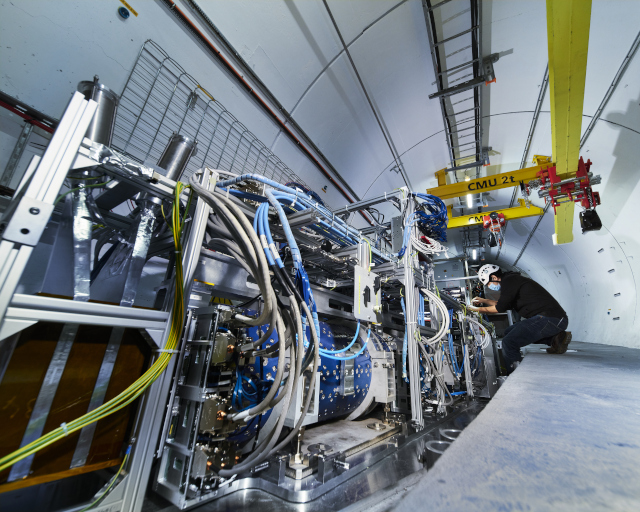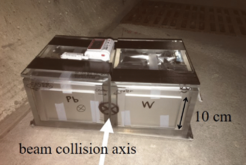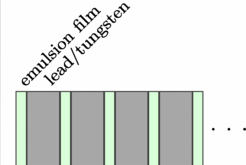
Pilot detector for FASER𝜈 detects neutrino-like interactions at the LHC
For the first time, neutrino candidates have been detected at the LHC. The FASER collaboration’s FASER𝜈 pilot detector has reported neutrino-like interactions using emulsion films, with a background-only result disfavoured at 2.7𝜎. This result inspires optimism for the larger FASER detector and FASER𝜈 neutrino subdetector, which are currently being installed and which will take data during the 2022-2024 LHC Run-3.
4 minute read
The ForwArd Search ExpeRiment (FASER) letter of intent and technical proposal was submitted to the LHC committee in 2018, with the aim of detecting and studying undiscovered light, weakly interacting particles as well as high-energy neutrino interactions. FASER𝜈, the neutrino subdetector for FASER, was approved in 2019 and will be operational for the 2022-2024 LHC Run-3.

Caption: The final elements of the FASER (Forward Search Experiment) detector are installed in the TI12 tunnel of the LHC. It is located along the beam collision axis, 480 m from the ATLAS interaction point, in an unused service tunnel and will be ready for physics data taking during the LHC Run 3. (Photo credit: CERN)
A pilot detector was installed in 2018 as a proof of concept for FASER𝜈, and took data for 4 weeks between September and October 2021. In November 2021, the FASER Collaboration confirmed that the pilot detected neutrino-like interactions – the first time candidates for neutrino interactions have been detected at the LHC.
Positioned in the same location as where FASER𝜈 will be, the pilot detector was located 480m from the ATLAS interaction point in the far-forward region. It collected 12.2 fb-1 of proton-proton collision data at 13TeV centre of mass energy with a 2% measured uncertainty. The positioning of the pilot detector, and eventually of FASER𝜈, was deliberately chosen to maximize the flux of all neutrino flavors and measure their interaction cross-sections in this previously unexplored high energy range. The pilot detector was not able to distinguish between neutrino flavours, but FASER𝜈 is expected to have this ability.


Caption: Structure of the pilot emulsion detector. Metallic plates (1-mm-thick lead or 0.5-mm-thick tungsten) are interleaved with 0.3-mm-thick emulsion films. Only a schematic slice of the detector is depicted. (Fig. 1 from Henso Abreu et al. (FASER Collaboration), First neutrino interaction candidates at the LHC, Phys. Rev. D 104, L091101, 10.1103/PhysRevD.104.L091101)
The 29kg pilot detector consisted of two emulsion film modules: a 14kg lead module with 101, 1mm thick lead plates alternating with 0.3mm thick emulsion films, and a 15kg tungsten module with 120, 0.5mm thick tungsten plates alternating with 0.3mm thick emulsion films. Each module was 12.5cm wide, and 10cm tall. These modules were placed side by side with the collision axis of the beam passing between them. The dense lead and tungsten components provide the material for neutrinos to scatter off while the emulsion film is the sensitive material that will be able to see the collision debris. After the 4 weeks of collecting data, all of the lead module layers and 15% of the tungsten module layers were used in the data analysis, with the rest of the tungsten plates having data quality issues that rendered them unusable.
The fiducial volume of the pilot was the total salvageable module layers minus 7 upstream layers, 5 downstream layers, and 5mm from each side, giving a total target mass of 11kg. Particle interactions are identified as tracks, which branch off from vertices. Neutrinos themselves do not produce tracks but their rare interactions in the detector can produce secondary particles that suddenly appear at a “neutral” vertex and flow forward through the detector. Neutrinos can be identified by reconstructing tracks and selecting vertices that pass specific criteria.

Caption: Event displays of two of the neutral vertices in the yz projection longitudinal to the beam direction (left) and in the view transverse to the beam direction (right). (Fig. 3 from Henso Abreu et al. (FASER Collaboration), First neutrino interaction candidates at the LHC, Phys. Rev. D 104, L091101, 10.1103/PhysRevD.104.L091101)
Within the fiducial volume, 18 vertices passed the selection criteria for neutrino interactions. After accounting for muon interactions using a boosted decision tree (BDT) algorithm, the calculated best-fit values are 6.1 events for neutrino signal and 11.9 for background. The background-only hypothesis is disfavoured with a statistical significance of 2.7𝜎.

Caption: The BDT outputs of the observed neutral vertices, and the expected signal and background distributions (stacked) fitted to the data. Higher BDT output values are associated with neutrinolike vertex features. (Fig. 6 from Henso Abreu et al. (FASER Collaboration), First neutrino interaction candidates at the LHC, Phys. Rev. D 104, L091101, 10.1103/PhysRevD.104.L091101)
The FASER𝜈 neutrino subdetector will be significantly larger than the pilot detector, with 1000 emulsion films and a target mass of 1.2 tons. FASER𝜈 will also have lepton identification capability. During the 2022-2024 LHC Run-3, FASER𝜈 is expected to detect over 10,000 flavour-tagged charged-current neutrino interactions. With this exciting result from the pilot run, and the increased abilities of the full FASER𝜈 detector, we optimistically await results from the FASER collaboration.
- First Neutrino interaction Candidates at the LHC (Phys. Rev. D, November 2021)
- First neutrino interaction candidates at the LHC (arxiv pre-print)
- Original News Release: UCI-led team of physicists detects signs of neutrinos at Large Hadron Collider
- Technical Proposal: FASERnu (arxiv pre-print)
- Find FASER on INSPIRE HEP
- Find FASER on arXiv
